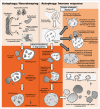Autophagy--A free meal in sickness-associated anorexia
- PMID: 27050464
- PMCID: PMC4836003
- DOI: 10.1080/15548627.2016.1147672
Autophagy--A free meal in sickness-associated anorexia
Abstract
Activation of the immune system is metabolically costly, yet a hallmark of an infection is a reduction in appetite with a subsequent reduction in metabolite provision. What is the functional value of decreasing nutrient intake when an infection imposes large demands on metabolic parameters? Here, we propose that sickness-associated anorexia (SAA) upregulates the ancient process of autophagy systemically, thereby profoundly controlling not only immune- but also nonimmune-competent cells. This allows an advanced impact on the resolution of an infection through direct pathogen killing, enhancement of epitope presentation and the contribution toward the clearance of noxious factors. By rendering a 'free meal,' autophagy is thus most fundamentally harnessed during an anorexic response in order to promote both host tolerance and resistance. These findings strongly suggest a reassessment of numerous SAA-related clinical applications and a re-evaluation of current efforts in patient care.
Keywords: anorexia; autophagy; infection; sickness behavior; xenophagy.
Figures


Similar articles
-
Sickness-Associated Anorexia: Mother Nature's Idea of Immunonutrition?Mediators Inflamm. 2016;2016:8071539. doi: 10.1155/2016/8071539. Epub 2016 Jun 29. Mediators Inflamm. 2016. PMID: 27445441 Free PMC article. Review.
-
Starvation and infection: The role of sickness-associated anorexia in metabolic adaptation during acute infection.Metabolism. 2024 Dec;161:156035. doi: 10.1016/j.metabol.2024.156035. Epub 2024 Sep 24. Metabolism. 2024. PMID: 39326837 Review.
-
Autophagy is a key tolerance mechanism during Staphylococcus aureus infection.Autophagy. 2015;11(7):1184-6. doi: 10.1080/15548627.2015.1058685. Autophagy. 2015. PMID: 26046478 Free PMC article.
-
Elevated plasma cholecystokinin at high altitude: metabolic implications for the anorexia of acute mountain sickness.High Alt Med Biol. 2000 Spring;1(1):9-23. doi: 10.1089/152702900320649. High Alt Med Biol. 2000. PMID: 11258590
-
Contribution of elevated protein turnover and anorexia to cachexia in patients with hepatocellular carcinoma.Cancer Res. 1990 Feb 15;50(4):1226-30. Cancer Res. 1990. PMID: 2153453
Cited by
-
Bone resorption: supporting immunometabolism.Biol Lett. 2018 Feb;14(2):20170783. doi: 10.1098/rsbl.2017.0783. Biol Lett. 2018. PMID: 29491030 Free PMC article. Review.
-
Nutrition, inflammation and cancer.Nat Immunol. 2017 Jul 19;18(8):843-850. doi: 10.1038/ni.3754. Nat Immunol. 2017. PMID: 28722707 Review.
-
Disease tolerance: concept and mechanisms.Curr Opin Immunol. 2018 Feb;50:88-93. doi: 10.1016/j.coi.2017.12.003. Epub 2017 Dec 15. Curr Opin Immunol. 2018. PMID: 29253642 Free PMC article. Review.
-
The good, the bad and the autophagosome: exploring unanswered questions of autophagy-dependent cell death.Cell Death Differ. 2019 Mar;26(4):640-652. doi: 10.1038/s41418-018-0267-4. Epub 2019 Jan 18. Cell Death Differ. 2019. PMID: 30659234 Free PMC article. Review.
-
Sickness-Associated Anorexia: Mother Nature's Idea of Immunonutrition?Mediators Inflamm. 2016;2016:8071539. doi: 10.1155/2016/8071539. Epub 2016 Jun 29. Mediators Inflamm. 2016. PMID: 27445441 Free PMC article. Review.
References
-
- Hart BL. Biological basis of the behavior of sick animals. Neuroscience & Biobehavioral Reviews 1988; 12:123-137; PMID:3050629; http://dx.doi.org/10.1016/S0149-7634(88)80004-6 - DOI - PubMed
-
- Ashley NT, Weil ZM, Nelson RJ. Inflammation: Mechanisms, costs, and natural variation. Annual Review of Ecology, Evolution, and Systematics 2012; 43:385-406; http://dx.doi.org/10.1146/annurev-ecolsys-040212-092530 - DOI
-
- Guo L, Zheng Z, Ai J, Huang B, Li XA. Hepatic scavenger receptor BI protects against polymicrobial-induced sepsis through promoting LPS clearance in mice. J Biol Chem 2014; 289:14666-14673; PMID:24719333; http://dx.doi.org/10.1074/jbc.M113.537258 - DOI - PMC - PubMed
-
- Schäfer G, Guler R, Murray G, Brombacher F, Brown GD. The role of scavenger receptor B1 in infection with mycobacterium tuberculosis in a murine model. PloS one 2009; 4:e8448; http://dx.doi.org/10.1371/journal.pone.0008448 - DOI - PMC - PubMed
Publication types
MeSH terms
Substances
LinkOut - more resources
Full Text Sources
Other Literature Sources
